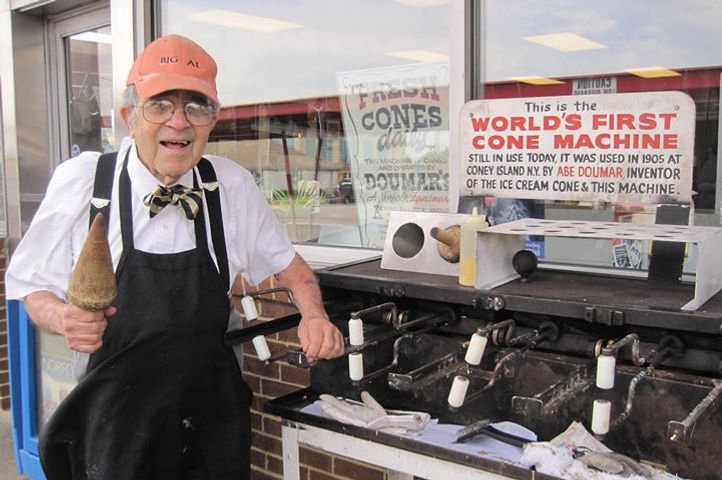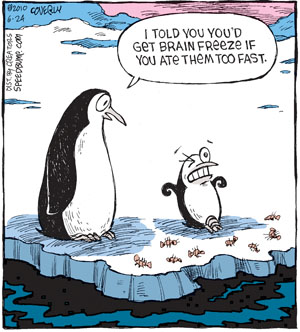Brain freeze is the sensation you get — that feels like your head is about to explode — when you drink something really cold really fast! When it hits, all you can do is stop what you’re doing and wait for it to pass.

But there’s another kind of brain freeze, which makes you feel like your head is about to explode; and it can stop you dead in your tracks; frozen in the pursuit of your goals; with your hopes, dreams, and every creative thought struck by a glacier of loss, disappointment, and despair. Too much rejection too soon can do it. So can dead ends, closed doors, missed opportunities, setbacks, weaknesses and failures.
The solution to brain freeze is to change one’s perspective on life, problems, and failures; and to foster a CAN-DO attitude. We need to look at our adversities as the perfect environment for personal growth; at setbacks as opportunities for comebacks; at our limitations as possible strengths; our problems as invitations for innovation; and a closed door as a sign to simply try a different door. And we need to learn to think outside the box! Hey, after all, necessity is the mother of invention.
Here are two examples of creative dreamers who avoided brain freeze by following this advice; two savvy businessmen who were definitely thinking outside (above, beneath, and all around) some sad situations that might have boxed in less enthusiastic people.
At the 1904 World’s Fair, held in St. Louis, Missouri, an ice cream vendor suffered an acute attack of brain freeze after he realized he was unprepared to meet the demand for his frozen treats. Although there was a steady stream of customers who wanted his product, the hapless vendor was nevertheless about to pack up and go home — all because he had run out of the small paper containers he used to serve the ice cream.
Enter Doumar the Undaunted! Actually, our hero’s name was just Doumar; Abe Doumar, a sixteen-year-old immigrant from Damascus, Syria, who at the time was working as a traveling salesman. Doumar had been mingling with the crowd at the World’s Fair, in an attempt to sell novelty paperweights, and he needed to take a break. He decided some ice cream would really hit the spot, but the first vendor he approached was “Mr. Brain Freeze” (he who hath no serving containers).
 Doumar took a quick look around, and noticed a pastry cart nearby, where a man was selling Belgian waffles topped with a dollop of whipped cream. So he walked over and purchased one served plain. As he returned to the ice cream vendor, Doumar gently rolled the soft, warm waffle into a cone. Then he asked Mr. Brain Freeze to fill the cone with a scoop of ice cream.
Doumar took a quick look around, and noticed a pastry cart nearby, where a man was selling Belgian waffles topped with a dollop of whipped cream. So he walked over and purchased one served plain. As he returned to the ice cream vendor, Doumar gently rolled the soft, warm waffle into a cone. Then he asked Mr. Brain Freeze to fill the cone with a scoop of ice cream.
Voila! The ice cream cone is born!
Doumar also suggested the two vendors join forces, and soon these men found themselves swamped with requests for warm waffles with ice cream. Other vendors working the fair quickly copied the innovation — there were around 50 ice cream stands and over a dozen waffle carts in the park that day — and hence, several different vendors wanted to take the credit for inventing the waffle cone. Regardless, the treat caught on in a big way, so that by 1924 Americans were consuming an estimated 245 million ice cream cones per year.
Doumar never bothered to patent his idea, but he did design the first machine built especially to bake cones. It was a four-iron waffle machine Doumar used three years later in Virginia, where, during the Jamestown Exhibition of 1907, he and his brother sold 23,000 cones in a single day.
Afterwards, Doumar designed a semi-automated, 36-iron waffle machine capable of turning out 20 cones per minute, and in 1934 he opened Doumar’s Drive In in Norfolk, Virginia. The restaurant is still open today, and still serving fresh waffle cones baked on Abe’s original 1905 four-iron machine.

Now, don’t think for a minute that Doumar didn’t suffer through his own share of adversity. He had to weather the destructive forces of a hurricane, endure a few economic slumps, as well as the ever-changing dining habits of a more suburbanized world. Through it all, however, Doumar avoided brain freeze by thinking warm, friendly, “we shall overcome” thoughts.
The Apostle Paul similarly overcame tremendous adversity in the form of persecution, beatings, and a stoning so severe that his friends left him for dead. Paul also endured cold, hunger, and loneliness. He was shipwrecked and afterwards survived a venomous snakebite — at a time when there was no antidote. (You can read of his travails in 2 Corinthians 4:8-18; 11:16-33 and Acts 27 through 28.)
But the much put-upon apostle who took the Gospel to the gentiles never suffered from brain freeze. Even while chained in a cold, damp, and dark cell in a rat-infested Roman prison, Paul wrote this warm proclamation: “I have strength for all things in Christ Who empowers me [I am ready for anything and equal to anything through Him Who infuses inner strength into me; I am self-sufficient in Christ’s sufficiency].” (Philippians 4:13 AMPC)
 In other words, “Whatever I have, wherever I am, I can make it through anything in the One who makes me who I am.” (Philippians 4:13 MSG)
In other words, “Whatever I have, wherever I am, I can make it through anything in the One who makes me who I am.” (Philippians 4:13 MSG)
This is a truth that can thaw the onslaught of brain freeze. Remember it. Confess it. Believe it. And refuse to be boxed in by your circumstances, limitations, or any adversity.
